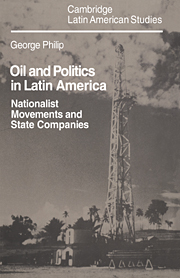Book contents
- Frontmatter
- Contents
- List of tables
- Preface
- Glossary
- Abbreviations
- Note on currencies and other units of measurement
- Maps: Latin America in 1920, 1940, 1960 and 1981; showing importing countries, exporting countries and countries self-sufficient in oil
- Introduction: The politics of oil in twentieth-century Latin America
- Part I The world oil environment
- Part II The major expropriations
- Part III The state oil companies
- 17 Pemex in Mexican politics 1938–79
- 18 The development of Petrobrás: oil company to conglomerate?
- 19 ypf 1932–1979: public enterprise or bureaucracy?
- 20 Petroperú 1968–80: achievements and hard lessons
- 21 ypfb and the development of oil in Bolivia
- 22 Petrovén: the birth of a giant
- 23 State oil companies in Latin America
- 24 Concluding reflections
- Notes and bibliography
- Index
- CAMBRIDGE LATIN AMERICAN STUDIES
20 - Petroperú 1968–80: achievements and hard lessons
Published online by Cambridge University Press: 23 December 2009
- Frontmatter
- Contents
- List of tables
- Preface
- Glossary
- Abbreviations
- Note on currencies and other units of measurement
- Maps: Latin America in 1920, 1940, 1960 and 1981; showing importing countries, exporting countries and countries self-sufficient in oil
- Introduction: The politics of oil in twentieth-century Latin America
- Part I The world oil environment
- Part II The major expropriations
- Part III The state oil companies
- 17 Pemex in Mexican politics 1938–79
- 18 The development of Petrobrás: oil company to conglomerate?
- 19 ypf 1932–1979: public enterprise or bureaucracy?
- 20 Petroperú 1968–80: achievements and hard lessons
- 21 ypfb and the development of oil in Bolivia
- 22 Petrovén: the birth of a giant
- 23 State oil companies in Latin America
- 24 Concluding reflections
- Notes and bibliography
- Index
- CAMBRIDGE LATIN AMERICAN STUDIES
Summary
The case of Petroperú well illustrates the difficulties inherent in setting up a model in which development is led by an autonomous and efficient state enterprise sector linking effectively with international technology and the world market. The difficulties in the Peruvian case were essentially political and managerial, although Petroperú suffered to some considerable extent from the vagaries of Peruvian geotogy. One conclusion may be that, whereas state enterprise is a feasible solution in countries where oil reserves are known to be abundant (Mexico) or where the domestic market is more important than domestic oil production (Brazil), state oil companies are not equipped to take major risks unless these are restricted to a minor part of their overall activity. Even more central is the fact that the creation of a successful state oil company is a difficult matter which requires a considerable degree of political as well as technical sophistication. Problems of economic policymaking do not disappear when foreign companies are nationalised.
The early politics of Petroperú 1969–71
After the expropriation of ipc in 1968–9 by the incoming military government, the state company Petróleos del Perú (Petroperú) appeared to have a considerable number of initial advantages. These stemmed from several different factors. One of the most important of these was the enormous amount of emotional capital invested in Petroperú. During the whole course of the debate on IPC, a main argument used by the opponents of nationalisation was the incompetence of state enterprise in Latin America.
- Type
- Chapter
- Information
- Oil and Politics in Latin AmericaNationalist Movements and State Companies, pp. 429 - 450Publisher: Cambridge University PressPrint publication year: 1982



